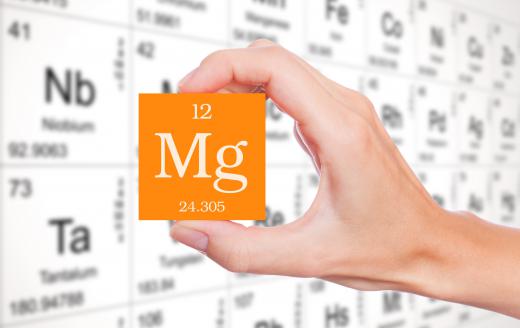What is Magnesium?
 Mary McMahon
Mary McMahon
Magnesium is an abundant metallic chemical element which has a number of industrial applications in addition to being vital for many living organisms, including humans. Its atomic number is 12, and the element is identified with the symbol Mg on the periodic table of elements. It is classified as an alkaline earth element, along with calcium and barium, among others. One of the more distinctive uses of magnesium is a source of illumination, since it burns bright white when ignited.
Sir Humphry Davy is generally credited with the discovery of magnesium, in 1808. It has been suspected that Davy actually discovered an oxide of the metal, ultimately inferring the existence of the element, but in either case the element was being readily extracted by the mid 1800s. One form, epsom salts, had already been used since the 17th century, and it continues to be readily available as a bath soak. Milk of magnesia, another popular remedy, also contains magnesium.

In nature, this element is always found in compounds with other substances, since it is reactive and it will readily blend with a wide variety of things. Seawater is an excellent source of magnesium, since the element is found in high concentrations there. A number of companies extract the element from seawater for a range of industrial uses. When isolated, it is a silvery white, extremely light metal. In elemental form, magnesium is essentially nontoxic, although shavings or dust are potentially explosive. When heated, it can spark toxic reactions, so facial protection should be used when working with hot magnesium.

Although magnesium is extremely light, it is also very strong. This makes it highly suitable for alloys, especially in the aerospace industry. Some high end automotives also use these alloys, since the metal can lighten the overall weight of a car, making it faster and more efficient. Magnesium is also used in illumination instruments. Some chemistry teachers like to set the shavings on fire to demonstrate the brilliant explosive qualities of the element for students.

In the human body, magnesium is among the top five most abundant elements. Approximately half in the body is concentrated in the bone, and the element contributes to a number of vital biochemical reactions. Generally, a healthy diet supplies enough of this mineral. An excess will lead to diarrhea, while a deficiency will cause neuromuscular problems. Leafy green vegetables happen to be a great source, along with other vital minerals.
AS FEATURED ON:
AS FEATURED ON:
















Discussion Comments
Is it advisable to drink mineral water than distilled or purified water? Mothers who have newly born babies are used to the practice of using distilled water for milk preparation,what are the advantages and disadvantages of it?
wow. i can't believe that such an important metal is so dangerous. there was a presentation in class today and the instructor accidentally set fire to a large amount of Mg. he used the extinguisher and it got worse. note to self if someone mentions pure magnesium, run!
thanks for the info. this helped a bunch with my science homework! keep it up!
Is it the same magnesium uses for plantation or agriculture, beside extract from seaweed? are there other materials that we can extract from magnesium?
Is it all right to take Milk of Magnesia when pregnant?
The USDA recommends anywhere between 400 to 500 mg of magnesium as a daily requirement. Men need a little more than do women. Not getting enough magnesium in the diet can contribute to constipation.
Post your comments